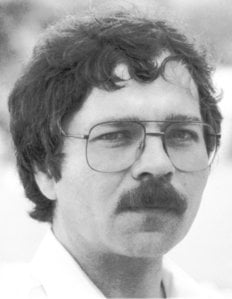J. Georg Bednorz
Biographical

I was born in Neuenkirchen, North-Rhine Westphalia, in the Federal Republic of Germany on May 16, 1950, as the fourth child of Anton and Elisabeth Bednorz. My parents, originating from Silesia, had lost sight of each other during the turbulences of World War II, when my sister and two brothers had to leave home and were moved westwards. I was a latecomer completing our family after its joyous reunion in 1949.
During my childhood, my father, a primary school teacher and my mother, a piano teacher, had a hard time to direct my interest to classical music. I was more practical-minded and preferred to assist my brothers in fixing their motorcycles and cars, rather than performing solo piano exercises. At school it was our teacher of arts who cultivated that practical sense and helped to develop creativity and team spirit within the class community, inspiring us to theater and artistic performances even outside school hours. I even discovered my interest in classical music at the age of 13 and started playing the violin and later the trumpet in the school orchestra.
My fascination in the natural sciences was roused while learning about chemistry rather than physics. The latter was taught in a more theoretical way, whereas in chemistry, the opportunity to conduct experiments on our own, sometimes even with unexpected results, was addressing my practical sense.
In 1968, I started my studies in chemistry at the University of Münster, but somehow felt lost due to the impersonal atmosphere created by the large number of students. Thus I soon changed my major to cristallography, that field of mineralogy which is located between chemistry and physics.
In 1972, Prof. Wolfgang Hoffmann and Dr. Horst Böhm, my teachers, arranged for me to join the IBM Zürich Research Laboratory for three months as a summer student. It was a challenge for me to experience how my scientific education could be applied in reality. The decision to go to Switzerland set the course for my future. The physics department of which I became a member was headed by K. Alex Müller, whom I met with deep respect. I was working under the guidance of Hans Jörg Scheel, learning about different methods of crystal growth, materials characterization and solid state chemistry. I soon was impressed by the freedom even I as a student was given to work on my own, learning from mistakes and thus losing the fear of approaching new problems in my own way.
After my second visit in 1973, I came to Rüschlikon for six months in 1974 to do the experimental part of my diploma work on crystal growth and characterization of SrTiO3, again under the guidance of Hans Jörg Scheel. The perovskites were Alex Müller’s field of interest and, having followed my work, he encouraged me to continue my research on this class of materials.
In 1977, after an additional year in Münster, I joined the Laboratory of Solid State Physics at the Swiss Federal Institute of Technology (ETH) in Zürich and started my Ph.D. thesis under the supervision of Prof. Heini Gränicher and K. Alex Müller. I gratefully remember the time at the ETH and the family-like atmosphere in the group, where Hanns Arend provided a continuous supply of ideas. It was also the period during which I began to interact more closely with Alex and reamed about his intuitive way of thinking and his capability of combining ideas to form a new concept.
In 1978, Mechthild Wennemer followed me to Zürich to start her Ph.D. at the ETH, but more importantly to be my partner in life. I had met her in 1974 during our time together at the University of Münster. Since then she has acted as a stabilizing element in my life and is the best adviser for all decisions I make, sharing the up’s and down’s in an unselfish way.
I completed my work on the crystal growth of perovskite-type solid solutions and investigating them with respect to structural, dielectric and ferroelectric properties, and joined IBM in 1982. This was the end of a ten-year approach which had begun in 1972.
The intense collaboration with Alex started in 1983 with the search for a high-TC superconducting oxide; in my view, a long and thorny but ultimately successful path. We both realized the importance of our discovery in 1986, but were surprised by the dramatic development and changes in both the field of science and in our personal lives.
This autobiography/biography was written at the time of the award and first published in the book series Les Prix Nobel. It was later edited and republished in Nobel Lectures. To cite this document, always state the source as shown above.
Addendum, 1991
Honours
Thirteenth Fritz London Memorial Award (1987), Dannie Heineman Prize (1987), Robert Wichard Pohl Prize (1987), Hewlett-Packard Europhysics Prize (1988), The Marcel Benoist Prize (1986), Nobel Prize for Physics ( 1987), APS International Prize for Materials Research (1988), Minnie Rosen Award, the Viktor Mortiz Goldschmidt Prize and the Otto Klung Prize.
Nobel Prizes and laureates
Six prizes were awarded for achievements that have conferred the greatest benefit to humankind. The 14 laureates' work and discoveries range from quantum tunnelling to promoting democratic rights.
See them all presented here.
